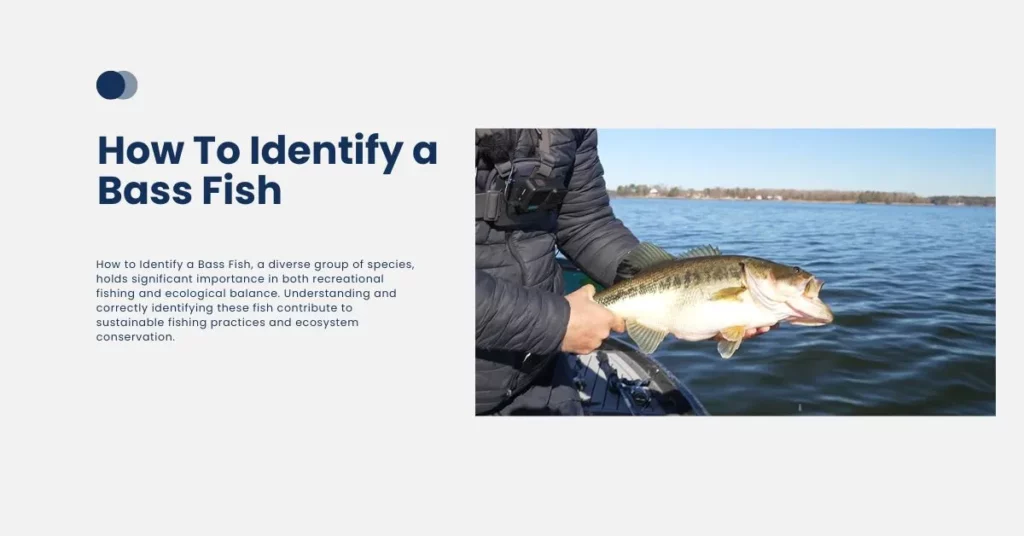
How to Identify a Bass Fish, a diverse group of species, holds significant importance in both recreational fishing and ecological balance. Understanding and correctly identifying these fish contribute to sustainable fishing practices and ecosystem conservation.
Among the bass species, the two main categories are black bass and temperate bass. This article will delve into the identification of one of the most popular black bass species – the largemouth bass.
Identifying a Largemouth Bass
Largemouth bass, typically 10 to 20 inches in length and weighing up to 22 pounds, possess distinct physical features. Their greenish-brown coloration, oval body shape, and large mouth extending past the eye set them apart.
Key identifiers include two dorsal fins with specific spines and rays, smooth cycloid scales, and a dark horizontal band along the sides. Distinguishing them from similar species, such as smallmouth and spotted bass, involves examining mouth size, color patterns, and fin characteristics.
Largemouth Bass Fishing Tips
Understanding why largemouth bass are a sought-after target for anglers is crucial. Their adaptability to various environments, aggressive and opportunistic feeding habits, strength, and acrobatic fighting style make them a thrilling catch.
Furthermore, when prepared properly, largemouth bass is not just a sport but can also offer a tasty and nutritious meal.
For successful largemouth bass fishing, selecting the right gear is paramount. This includes choosing appropriate rods, reels, lines, hooks, and nets. Equally important is the selection of baits and lures, ranging from live options like worms, minnows, and crayfish to artificial lures such as spinnerbaits, crankbaits, jigs, and flies.
Knowing where to fish, including areas near cover like weeds, rocks, and logs, the timing (dawn, dusk, or after rain), and using effective techniques such as casting, retrieving, jigging, or trolling, contribute significantly to a successful angling experience.
Responsible practices, like catch and release or adhering to legal size limits, ensure the sustainability of largemouth bass populations.
Where to Catch Largemouth Bass
Largemouth bass, being a truly global species, inhabit various regions across the continents.
In North America, states like Texas, Florida, California, and Alabama offer prime bass fishing locales, along with Canadian provinces such as Ontario, Quebec, and British Columbia. Mexico boasts notable sites like Lake Baccarac and Lake El Salto.
In South America, Brazil’s Amazon River and Pantanal, along with Argentina’s Paraná River and Iberá Wetlands, are known havens. Moving to Africa, South Africa’s Vaal River and Lake Kariba, and Egypt’s Lake Nasser and Nile River are noteworthy.
In Asia, Japan’s Lake Biwa and Lake Kasumigaura, China’s Yangtze River and Pearl River, and in Europe, Spain’s Guadiana River and Ebro River, as well as Italy’s Lake Garda and Lake Maggiore, present exciting opportunities for largemouth bass enthusiasts.
Understanding the regulations and conservation status of largemouth bass in different regions is essential. Legal size and bag limits can vary significantly, often dictated by state, province, or country regulations.
Some areas necessitate fishing licenses or permits specifically for largemouth bass. Special seasons or rules, such as catch and release only, barbless hooks only, or slot limits, might be in place.
It’s noteworthy that largemouth bass, while prized in many regions, are considered invasive species in certain areas, notably in Europe, Asia, and Africa, where their presence poses a threat to native fish and ecosystems.
How to Catch Largemouth Bass
Largemouth bass are found in diverse regions worldwide. North America, South America, Africa, Asia, and Europe offer prime locations for bass fishing. Understanding regional regulations, fishing license requirements, and conservation efforts is essential for responsible angling. In some areas, largemouth bass are considered invasive, posing threats to native species and ecosystems.
Conclusion
In conclusion, a nuanced understanding of largemouth bass, from identification to fishing techniques, is essential for both avid anglers and conservationists. As stewards of aquatic ecosystems, it is our responsibility to engage in responsible fishing practices and contribute to the preservation of these iconic species for future generations.
Frequently Asked Questions
What is a largemouth bass, and why is it significant?
Largemouth bass (Micropterus salmoides) is a popular freshwater fish known for its large mouth and aggressive behavior. It holds significance in recreational fishing due to its adaptability, wide distribution, and thrilling fight when caught.
How do you identify a largemouth bass?
Largemouth bass can be identified by their oval body shape, greenish-brown coloration, large mouth extending past the eye, and a dark horizontal band along the sides. They have two dorsal fins, the first with spines and the second with rays, and smooth cycloid scales.
How does a largemouth bass compare to other black bass species?
Compared to similar species like smallmouth bass and spotted bass, largemouth bass has a larger mouth, distinctive coloration, and unique fin characteristics. Florida bass share similarities but differ in eye size, jaw length, and coloration.
What are the key physical features of a largemouth bass?
Largemouth bass typically measure 10 to 20 inches in length and can weigh up to 22 pounds. They have an oval body, greenish-brown color, a large mouth extending past the eye, and smooth cycloid scales with 59 to 65 along the lateral line.
Where can largemouth bass be found globally?
Largemouth bass are found in various regions worldwide, including North America (e.g., Texas, Florida), South America (e.g., Amazon River), Africa (e.g., Lake Kariba), Asia (e.g., Lake Biwa), Europe (e.g., Ebro River), and more.
